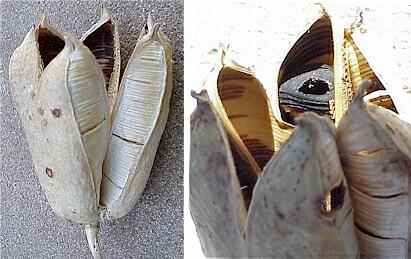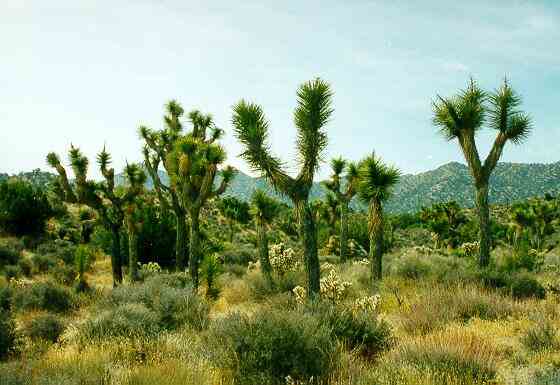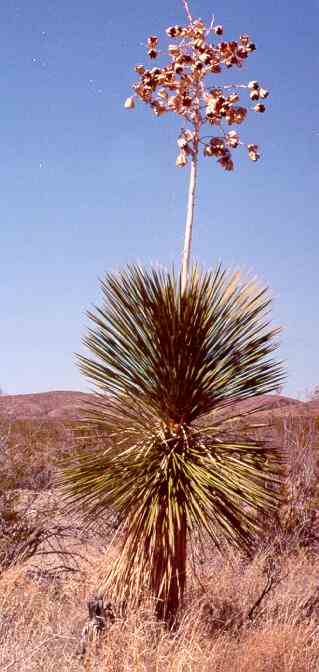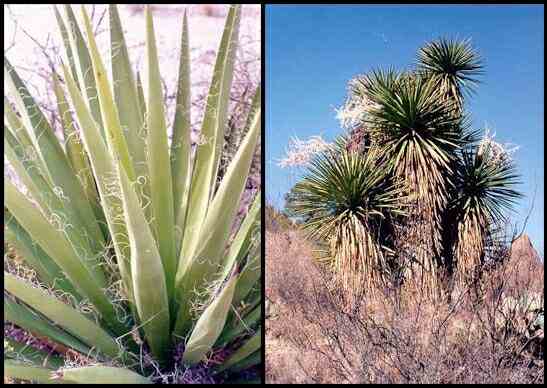| YUCCA
SPECIES All yuccas are in the Agave family (Agavaceae). They have stiff, succulent, perennial leaves and produce creamy-white, waxy flowers. They are found in the higher elevations of many of the North and Central American deserts, and are tolerant of cold winters. The many species of Yucca are difficult to distinguish from one another, but some are highly characteristic. The largest yucca is the Joshua tree (Yucca brevifolia), which has much-branched stems and can grow to a height of 10 to 15 metres. This plant is highly characteristic of the Mojave desert: its distribution largely defines the boundaries of this desert. Other characteristic species shown here are soaptree yucca (Y. elata), banana yucca (Y. baccata) and Spanish bayonet (Y. schottii). All yuccas have a highly characteristic means of pollination by female yucca moths of the genus Tegeticula. This is a truly mutualistic association, benefitting both the plant and the moth (which depends on yuccas for its survival). After mating, the female moth gathers pollen from the yucca flowers then flies to a different yucca plant and lays her eggs in the ovary of the flower. Then she inserts a ball of pollen into a special depression in the stigma of the flower, to ensure that the flower is fertilised. This pollination system is so precise that only yucca moths can pollinate these plants - yuccas grown in regions where the yucca moth is absent will never produce seeds unless the plants are hand-pollinated. After fertilisation, the seeds develop within the flower's ovaries. At this stage the eggs of the moth hatch and the young larvae feed on the seeds, eating their way through some of the columns of seeds (see below).
This mutually beneficial arrangement is so tightly regulated that Yucca plants abort their fruit development if the moth lays too many eggs in the ovary. This ensures that at least some viable seeds will be produced each year, while some also will be eaten by grubs, so that the survival of both mutualistic partners is maintained.
Joshua trees (Yucca brevifolia) forming a dominant tree-like "forest" over a grassland zone in the Joshua Tree National Park, USA. Although they look "woody", the stems of these trees do not have annual rings; instead they are fibrous and are coated with the remains of dead leaves.The leaves are short (about 30 cm long) and densely clustered near the tips of branches.
Some of the Joshua trees in this image have the remains of flower stalks. The growing point dies after flowering, and a new growing point emerges as a branch beneath this. Thus the trees become progressively more branched with age. Individual trees can live for perhaps 200 years or more.
Soaptree yucca (Yucca elata), characterised by its narrow leaves and erect flowering spike. The plant shows the remains of the fruit capsules from the previous flowering season. Soaptree yucca gains its name from the high content of saponins in the trunk and roots. These soap-like compounds were used for shampoo and soap by indigenous Indians.
Left: Stiff, spine-tipped leaves of banana yucca, with white fibres caused by shredding of the leaf margins. In the past, yucca fibres have often been used by indigenous Indian tribes for making mats, baskets, cloth, rope and sandals. Right: Clump of Schott's yucca (Yucca schottii), commonly termed Spanish bayonet. This species has lance-shaped leaves up to 90 cm long, and can grow to a height of 5 metres. It is found mainly on hillsides and in canyons at high elevation (4000 to 7000 feet).
Banana yucca (Yucca baccata), showing the cluster of sweet-smelling, creamy-white flowers (photographed in May).
Yuccas leaves are a major source of fibres for basket-making and other types of weaving by native American people. These fibres are clearly seen in the shredded outer margins of the leaves in the image above. Go to: |






